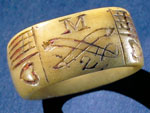It would have surprised the tens of thousands of men who found themselves casualties of fighting in 1864 to hear that the Civil War had essentially ended the year before. Indeed, some of the bloodiest fighting of the war (especially during the Overland Campaign in Spring 1864) occurred after July 1863. So the short answer to the first question is yes, we are guilty of looking backwards when we argue that Gettysburg was the decisive moment in the Civil War. Hindsight is a powerful tool and can create great gains for understanding, but it can also warp how we see the past and produce false insights. Viewed contemporaneously, the Civil War (as with most wars) had no single moment that participants could identify as the fulcrum point.
But the war did have several crucial moments visible both at the time and later, that clearly channeled the conflict in different directions. A short list of these moments include Lee's repulse of McClellan's army on the peninsula below Richmond in Spring 1862, the Union victory at Antietam and Lincoln's subsequent issuance of the Emancipation Proclamation, the simultaneous Union successes of Gettysburg and Vicksburg in July 1863, the Union capture of Atlanta in Summer 1864, and Lincoln's reelection in November of that year. At all of these moments, events transformed the conflict in fundamental ways. Lincoln's decision to make emancipation a Northern war aim probably marks the single most important shift in the course of the war.
[Gettysburg] marked the fullest and, in some respects first, clear defeat of Lee's army by Union forces.
Therefore, neither side saw Confederate defeat at Gettysburg as the moment that determined Union victory. But there is also no denying that it was a pivotal moment. It marked the fullest and, in some respects first, clear defeat of Lee's army by Union forces. It also did massive damage to the personnel of that army—both enlisted men and officers. That the victory was announced to the nation on July 4 in tandem with news of Vicksburg's capture ensured it would resonate with a special significance regardless of what happened later. In many respects, the final capture of Vicksburg (which had taken Ulysses S. Grant and his men almost six months) was more important—it cleaved the Confederacy in two, restored full control of the Mississippi River to the Union, and demoralized Confederates who had long believed the city to be impregnable. But many more people, foreign and domestic, followed battles in the East, and to many Lee's defeat marked a shift in the war's course. Union soldiers were elated by their victory, leaving the Confederates shamed and chagrined. The challenge was for the Union to follow up and this it failed to do. The Union army followed Lee back into Virginia but there was no major fighting in the region for the remainder of 1863. The next major eastern battle following Gettysburg did not occur until May 1864.

